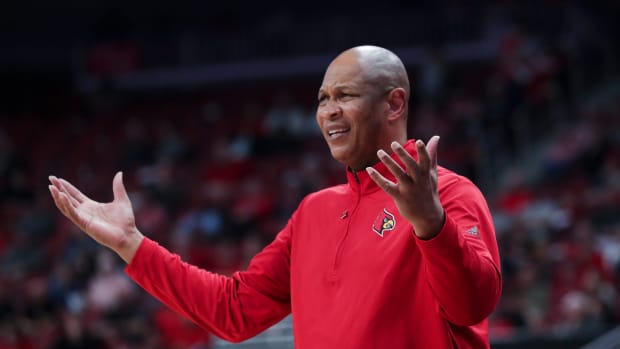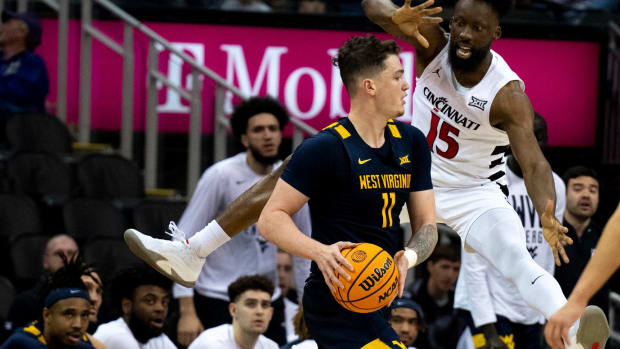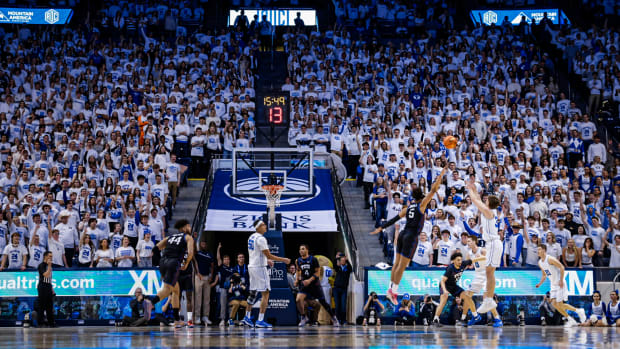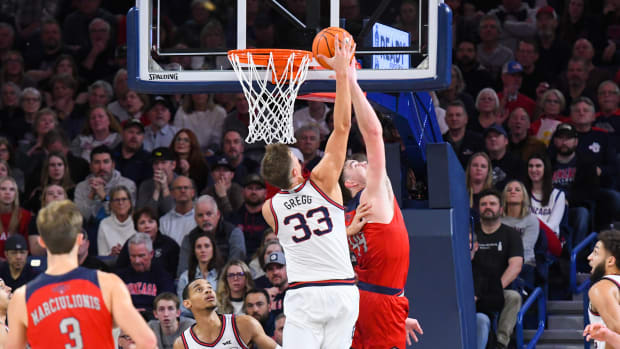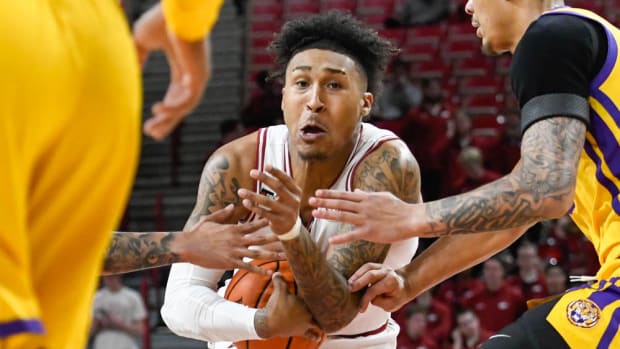The Long Journey of Maryland 7-Footer Chol Marial to College Basketball
Five nights before Christmas, the visiting basketball locker room at Newark’s Prudential Center was a somber scene. Heads were buried into hands, eyes were fixed on the carpet and Maryland coach Mark Turgeon was leaning against a brick wall, having shed his suit jacket and opened the floor to his players. Then No. 7 nationally, the Terps had just lost to unranked Seton Hall, 52-48. Naturally, such a disappointing setback spawned some soul-searching.
A pair of predictable suspects talked first in the postgame postmortem: senior point guard Anthony Cowan Jr. and sophomore big man Jalen Smith. Respected team leaders and the Terps’ two leading scorers, they both delivered messages of unity in tough times. Then a third, unlikelier voice piped up from the back of the locker room. Heads turned around, snapping to attention.
“We’ve got to bring it every day, [until] nothing’s left in your body. You’ve got to go and bring it.”
The speaker hadn’t logged a single minute against the Pirates that Thursday evening. He hadn’t even appeared in a single game during the ‘19-20 season. And yet perhaps no Terps player was better positioned than freshman center Chol Marial, with his gangly 7’2” frame scrunched into a folding chair and his elbows propped on his surgically repaired legs, to preach about the importance of perseverance. After all, it’s hard to imagine that many others in college basketball have traversed more ups and downs, over such a short time, to reach the sport’s biggest stage.
Marial didn’t address his teammates for long after the Seton Hall loss. Fifteen seconds, max. If he felt nervous about contributing, though, it didn’t show. “When he spoke, everybody listened,” Turgeon would say later. The words were firm and confident, his message punctuated by some air-slicing hand gestures with his right hand—the same hand sporting a bracelet with the tricolor red, green and black of the South Sudan flag. That is where his journey begins, before the shin splints and sleepless nights and endless rehab, before the viral-video attention and blue-chip recruiters and four high schools in five years, even before he boarded a flight to the U.S. by himself at age 14, knowing almost no English but still knowing that he needed to chase a dream…
It all comes back to Rumbek, and the story about the lion.
***
The leonine legend is well known in the Terps basketball program by now, mostly because Marial relayed a version to Turgeon during his recruiting visit to College Park last spring and word spread. But here’s the gist: Long before baby Chol (SH-oal) was born, his father, a colossus-sized cattle rancher named Beny Chuar, killed a lion. The exact reason why is unclear, although apparently the beast had been terrorizing citizens in Chaur’s village. Asked how the deed was done, Marial describes a spear-like weapon and close combat resulting in a broken arm.
“A big dog,” he says, grinning with pride. “My dad was that strong.”
As to be expected, the heroic act brought Chaur great respect from the community; Marial’s biography on the Maryland athletics website characterizes Chaur as “an elder in hometown village of thousands; some call him a ‘king.’” Years later, when Marial first took up basketball, familial lore would inspire another nickname in Rumbek, the capital of South Sudan’s Lakes State where he was raised. “I play hard,” Marial says. “And they call me Lion.”
Soccer was his first sporting love. A striker, of course. “Oof, I was nasty,” he says. “I was taller than all the kids.” Basketball didn’t come onto his radar around age 10, when one of his 16 siblings—seven sisters, nine brothers, Marial says, adding that he's "in the middle" age-wise—returned from university with a new hobby for himself and two gifts for Chol: a pair of oversized sneakers, and a Kevin Garnett Celtics jersey.
Two more years passed before Marial began seriously learning to play, tagging alongside that same older brother to watch pickup at the nearest gymnasium. “They wouldn’t allow me to play, because I didn’t know how,” Marial says. “So when they leave, I just shoot around. Learn how to make layup.” The gym was several miles from his house, so sometimes Marial hitched a ride on the motorbike of a local coach; other mornings he made the trek alone on foot to hoist shots before anyone else showed up. “Go early,” he says. “You have to really want it.”
From the outset, Marial loved basketball for what it provided a humble kid from Rumbek who describes his childhood like this: “Just grow up, go to school, come back home, watch cattle, stay with my dad, play soccer.” A kid who recalls hearing about Kobe Bryant and Michael Jordan, but swears that he couldn’t have picked them out of a lineup, given that his family had neither TV nor internet.
For starters, Marial couldn’t believe how much free gear was dispensed at tournaments. “I got clothes, I got shoes, I was like, ‘Okay! It’s good! Better than soccer!’” Marial says. “Soccer, we didn’t get nothing.” On a deeper level, though, were the doors that were suddenly opening to him around the world.
At 13, Marial left his family for the first time to attend a tournament in nearby Wau. His first flight—and first trip out of Lakes State—was taken to the city of Juba for two months of intense training, followed by his first trip out of South Sudan to the NBA’s 2013 Basketball Without Borders camp in in Johannesburg, and his first time off the continent to join an all-star team of regional youth talent in Dubai.
It all added up to an easy decision for Marial about pursuing basketball full-time. “When I get to travel,” Marial says, “I was like, ‘Yeah, I’ve got to do this right now. Might change my life.’”
***
The teenager ducked out of the plane and entered the bustling terminal at Orlando International Airport. It was Sept. 2014 and Marial had just arrived in the U.S. alone, having bid farewell to his father, mother Yar Gorjok and siblings in Rumbek. A coach from West Oaks (Fla.) Academy, where Marial was to spend his eighth-grade season on an I-20 student visa, was supposed to pick up Marial at the airport. Absent any significant English-language command, the 14-year-old flagged down a helpful-looking family, showed them a phone number, and asked them to dial the coach to explain where he could be found.
“The good thing?” Marial says. “I learned a lot quick.”
The hoops world took notice. “Tallest Middle Schooler in the World - Basketball Prodigy,” screamed the headline of one YouTube highlight video from June 2015, which boasts more than 1.1 million views today. “Kinda go viral,” Marial says.
Towering above his AAU competition in the footage, Marial is shown swatting shots above the rim, executing between-the-legs dunks as easily as dropping loose change into a tip jar, and sitting uncomfortably on the bench with his knees coming up to his chin. Pretty soon, peers were approaching Marial on campus, asking for pictures and gushing about how cool it was that he was ranked.
“What is that?” Marial replied. “What is ranked?”
Again, he learned quick. By early 2017, national recruiting sites had placed Marial among the top prospects for the entire class of 2019; at one point he was ESPN’s No. 1 center. Coaches from Kansas, North Carolina and UCLA called. A profile in the New Haven Register, meanwhile, outlined a tantalizing future for the then-sophomore at Cheshire (Conn.) Academy: “In a few years, Chol Marial could be the No. 1 overall pick in the NBA draft, posing for a picture with commissioner Adam Silver and beginning what he hopes will be a lucrative pro career.”
“I was different that time,” Marial says today, eyes glowing at the memories. “So different.”
Then came the pain. After his sophomore season ended prematurely due to shin splints, Marial transferred to Florida’s IMG Academy, hopeful that its vast athletic resources could help him heal faster. Instead, Marial only appeared in 17 games, unable to string together a consistent healthy stretch. “Hurting, hurting, hurting,” he says. “It never really get worse, and it never really go away. Just, in the middle.”
Even worse, college interest waned. “When I got hurt, no one text me, no one call me no more,” he says. “It just stopped. My ninth and tenth grade years? Pssh, I probably got 20 calls a day at the time coaches are allowed to call you. It was crazy. But when I got hurt?”
He whistles, a high note falling to a low one.
“Nothing.”
***
After a brief visit to Rumbek, Marial enrolled at AZ Compass Prep for his senior year in ‘18-19, choosing the public charter school because of its proximity to some cousins in nearby Phoenix. (It also helped that another South Sudanese prospect, Both Gach, now a sophomore guard at Utah, had recently attended Compass.) The change of scenery raised Marial’s spirits, as did a strong support system of family and friends. But his health never improved.
In March, the night before Compass was due to fly to Kentucky for a national tournament, Marial awoke in tears due to the pain coursing through his legs. He had been hoping to rejoin the team at the tournament after weeks of rehab, having appeared in fewer than a dozen games that season. Instead, an MRI revealed stress fractures and he never played for the school again.
“The fact that he never gave up, he deserves all the credit in the world,” says Zy Owens, who acted as Marial’s guardian in Arizona. “There were times he thought, ‘Maybe basketball isn’t for me.’ But he never, ever gave up 100%, because he always knew where he could get.”
Far removed from the national spotlight, Marial continued to work, driven to become the first member of his family to earn a high school diploma. On top of the core-only course loads that he was taking to earn NCAA eligibility, Marial would receive nightly tutoring sessions from Ronda Owens, the CEO of the 501(c)3 that runs Compass and Zy’s mother, whom Marial lived with throughout the school year. Sure enough, Marial not only walked at Compass’ graduation in May 2019—his diploma was officially earned one month later after the completion of two summer classes—but he was chosen to deliver the student commencement address.
“I know I can do anything I want to do in my life, as I have come from Africa to United States, and gained world knowledge, and tonight a high school diploma,” he said in his speech. “Now I’m going to start another journey at Maryland … I plan to play basketball. I plan to make those who help me along this way proud of me. I eventually want to become an NBA basketball player someday.”
The crowd loved this last line, breaking into applause. Marial grinned, the cord of his cap dangling high above the dais.
***
A few days before the Seton Hall loss, Marial stood in his dorm room at Maryland, giving a tour to a visiting reporter. A stack of textbooks was piled high on the desk, next to a framed picture of his parents and several siblings from Rumbek. A motivational poster featuring the image of a lion was tacked above the bed, a gift from Ronda Owens before Marial left for school this fall.
In a similar vein, the woman whom Marial calls his “American mom” had recently shipped him a necklace with a golden lion pendant to commemorate his first college basketball game … whenever that finally happens. “Just to get a chance again to play,” he said, is “going to be very exciting. Maybe fantastic.”
The hardships did not end when Marial first walked onto campus, for the simple fact that he could barely walk. Accompanied by Turgeon to one doctor’s evaluation over the summer, Marial was asked to jump off each leg to test its strength; the left sprung about one inch into the air, according to Turgeon, and his right couldn’t elevate at all. The diagnosis: bilateral stress fractures in both tibias. And since years of conservative treatment hadn’t helped, surgery was recommended as the best course of action.
Marial had never taken pain medication stronger than Tylenol until he reported to the University of Maryland Shock Trauma Center in Baltimore before dawn on Sept. 4. (It was also the first time, he says, that any member of his family had gone under the knife.) Eight or so hours later, Marial awoke with 50-centimeter “tibial nails” inserted in each leg to stabilize the bone, according to Terps athletic trainer Matt Charvat; if his limbs had been any longer, the surgical team would’ve needed to order custom-length rods.
True to his roots, though, Marial didn’t take long before attacking his rehab, taking heed of what Charvat had told him mere hours after surgery at the hospital: “Let’s kick that lion in and get to work.” The next day, Marial began walking on crutches.
Back at his dorm three months later, Marial does some mental math. Since his shin splints first developed in late 2016, he estimates that he has played no more than 30 total games of competitive basketball. Overcoming that much of a layoff would be hard enough for any college player, but Marial is also balancing academic commitments from 8 a.m. to 3 p.m. every day at the Maryland English Institute, continuing to build fluency in his third language (Dinka, Arabic). As a result, he has barely been able to watch his Terps teammates practice, let alone join them. Once again, Marial was resigned to getting shots up solo after everyone else had left the gym.
But that is changing. Twelve weeks post-op, Marial was cleared to start practicing and quickly turned heads. Several members of the program point to a 4-on-4 scrimmage during an off day at the Orlando Invitational in early December, fittingly enough not far from where Marial first landed in the country. Most of Maryland’s rotation regulars were resting on the sidelines, where they raved over Marial’s smooth shooting stroke, strong defensive timing and raw athleticism packaged in a 7’2”, 235-pound frame with a 7’8 ¼" wingspan.
Even as his dream was delayed, Marial remained his usual energetic, optimistic self. When walk-on Reese Mona hit a three against Oakland in mid-November, the first of his career, Marial flopped onto the floor on his back and flailed his limbs in celebration. Another time, he grabbed a plush turtle from some boosters seated courtside and helicoptered the stuffed animal around his head.
By all accounts, College Park has been an ideal fit. Marial loves the international flavor of his classes at the Maryland English Institute, where he is one of the only athletes. He shares an apartment suite with two senior teammates in Cowan and Travis Valmon and student manager Brendan Maranz, who jokes that he's still not sure how Marial fits in the shower.
He is learning to type on a computer—“I do it like chicken,” he says—and reports recently trying nachos for the first time. Around campus, he happily poses for pictures with fellow students. “A lot of them are really nice, they come and say hi,” he says. “Like, ‘Yeah, man, we cannot wait to see you out there!’”
Marial committed to Maryland in early May as the 13th and final scholarship on Turgeon’s roster for ‘19-20, choosing the Terps over New Mexico, Arizona State and Grand Canyon University—the four schools that bothered seriously recruiting Marial after his injury. Since then, though, he has largely existed as a curious mystery for every Terps player, coach and fan, a tantalizing talent with the potential to alter Maryland’s season … whenever he actually took the floor.
“Atrophy would be the word that springs to mind,” Terps assistant coach Matt Brady says. “All of his talents have been unused.”
But Turgeon and his staff have been careful to tamp down expectations. Marial was medically available for the Seton Hall game but remained on the bench as the Terps battled from an early deficit.
The wait wouldn’t last much longer.
***
On the Sunday afternoon after Christmas, which he spent back in Arizona with the Owens family, Marial debuted with 13:07 remaining in the first half against Bryant, receiving a massive ovation—as massive as ovations get on the Sunday afternoon after Christmas against Bryant—from the moment that he stood up from the bench.
Over the next four minutes, far longer than Turgeon had originally planned to leave him in, Marial slammed two put-back dunks and grabbed three rebounds, finishing with six points, five boards and one block as the Terps coast to an 84-70 rout.
“If he was in shape, he’d play 40 minutes,” Turgeon said postgame outside the Terps locker room, “but we’ll bring him along slowly. Really happy for him. He’s been through a lot.”
A little while later, Marial sat in the empty players lounge at Xfinity Center, picking at a barbecue chicken sandwich. His phone is jangling with dozens of texts and social media messages from family, friends and old coaches. “I got some looooove on Instagram,” he says. Asked to describe how this feels, he flashes that familiar, toothy smile.
“Lit,” he says.
And what does lit feel like?
“When you stay two years away from home, and then you go home, you’re feeling lit.”
Indeed, Rumbek is never far from his mind. He can’t wait to buy his parents a house, and a “good car,” and maybe even a flight to see him play in some NBA city. He has talked with Zy and Ronda Owens about the future possibility of founding an elementary school, aiming to help the children who greet him at the airport whenever he returns to South Sudan, or flock to watch him work out at the local gym.
“That gives me motivation,” he says. “That’s why I want to go harder, so I can help them. They want to play basketball, but they don’t have shoes. Giving them shoes or a basketball to play, that’s going to change the kids’ lives. They can have a chance to go somewhere, to come to America, like I had a chance to come here.”
There was a time when Marial was considered a one-and-done lock, or even a straight-to-the-NBA prospect, given that he was eligible for the draft of high school because he graduated at 19. His immediate future is less certain now, but Marial is not some raw project requiring years of incubation either; new bits of talent are revealed at practice every day: a knockdown three, a soaring dunk, a teammate’s shot swatted above the rectangle on the backboard.
“I could probably take him down on the block right now and score around him,” Turgeon says. “Where, a month from now, not many people in the country will be able to score over him, or around him, near the basket.”
“Four years ago, I would’ve said that he’s a guy who’s going to play in the NBA and have a long career,” Brady says. “I still think that’s his ceiling, if he’s healthy.”
Ready or not, the No. 15, 11–2 Terps will be counting on Marial to contribute more when Big Ten competition starts in earnest on Saturday against Indiana, especially with 6’10” twins Makhi and Makhel Mitchell having entered the transfer portal in late December. Judging by his 14-minute stint against Bryant, though, Marial will be just fine. There was some rust, of course: a fumbled entry pass, a blocked hook shot attempt. But none of those hiccups dampened the emotion of the moment for Marial and those who understand his journey. Like one of his cousins, whose congratulatory Facebook message was accompanied by an emoji of the king of the jungle:
“Good job lion. You have showed the world what you are built for.”




